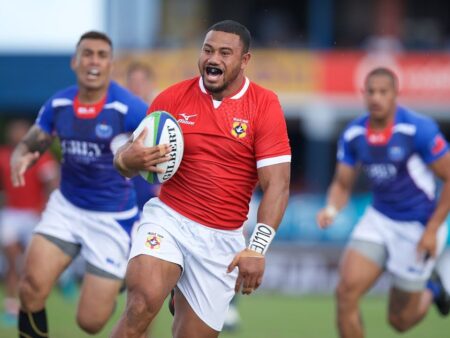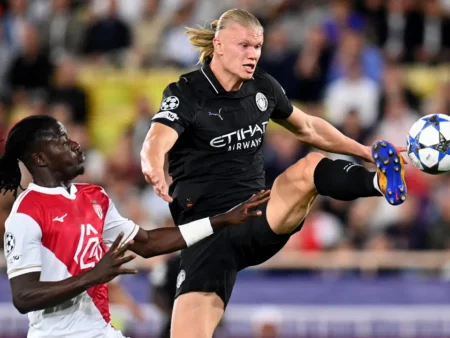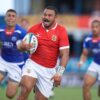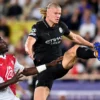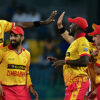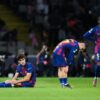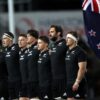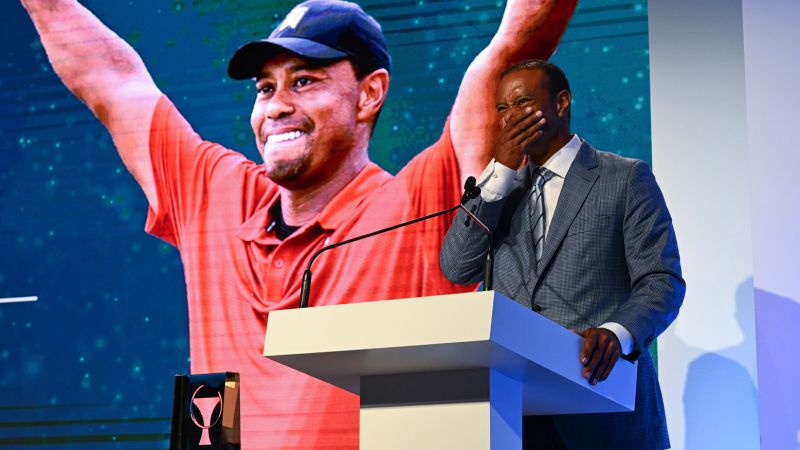
Twenty-five years ago, the 2000 U.S. Open held at Pebble Beach Golf Links in California was a poignant event. It served as a tribute to the life of the previous champion, Payne Stewart, who had tragically passed away in a plane crash less than eight months prior.
The tournament also marked the final U.S. Open appearance for the 18-time major winner Jack Nicklaus, playing in his 44th championship.
However, the event ultimately transformed into a monumental coronation for Tiger Woods, who delivered one of the most outstanding performances in the history of men`s professional golf over the four days of competition.
Woods arrived at Pebble Beach just three weeks after securing his 19th PGA Tour victory, and his fourth of the season, with a five-stroke margin at the Memorial Tournament. This win made him the first player to claim back-to-back victories at the event hosted by Jack Nicklaus.
In fact, Woods had been exceptionally dominant, winning 11 out of his last 20 PGA Tour starts leading up to the U.S. Open. His recent wins included a playoff victory over Ernie Els at the Mercedes Championship, a come-from-behind win against Matt Gogel at the AT&T Pebble Beach National Pro-Am where he overcame a seven-stroke deficit in the final seven holes, and a decisive four-stroke win at Arnold Palmer`s Bay Hill Invitational.
At the young age of 24, Woods had already made history as the first golfer to earn over $15 million in career on-course earnings. He had previously won the 1997 Masters by a record 12 shots and the 1999 PGA Championship at Medinah Country Club, putting him halfway to achieving the career Grand Slam.
Following a tie for third place, just two strokes behind Stewart, at Pinehurst No. 2 the previous year, Woods was widely considered the overwhelming favorite to win the U.S. Open again.
“If the conditions are dry and windy, then it`s a matter of patience,” Nicklaus commented before the tournament began. “But if they`re throwing darts, then Tiger will shoot a tremendously low score, no matter what the conditions are. And he`ll probably break the Open record.”
The standing U.S. Open 72-hole scoring record of 272 was set by Nicklaus himself in 1980 at Baltusrol Golf Club in Springfield, New Jersey, and later tied by Lee Janzen at the same course in 1993.
Given Woods` scorching form, the U.S. Open scoring record seemed unlikely to remain untouched.
“He had already arrived in a big way in one tournament [at the 1997 Masters], but that was the start of Tiger winning tournaments by a lot of shots,” said Stewart Cink. “Not just winning but like oh-my-gosh winning, more than five or six shots. That`s just unheard of considering how close all of us are together as far as skill.”
Australia`s Stuart Appleby, a three-time PGA Tour winner at the time, offered a more succinct assessment of Woods` prospects, stating, “Tiger would be favored anywhere. Put him in a car park and he`d be favored.”
“Never Seen Anything Like It”
As Woods commenced his preparations at Pebble Beach on Sunday, his caddie, Steve Williams, quickly recognized that Woods was once again poised to be the dominant force on the Monterey Peninsula.
Three weeks prior, Woods had competed in the Deutsche Bank Open in Germany, where he reportedly received a substantial fee to defend his European Tour title. In the final round, a double bogey on the 11th hole after hitting his second shot into the water contributed to him tying for third, four strokes behind the winner. It was only the second time in his career up to that point that he failed to win after holding the 54-hole lead.
After observing Woods hitting practice balls on Monday morning, Williams and Woods` swing coach, Butch Harmon, suggested he reduce his practice workload before the tournament officially started.
“We didn`t want Tiger to overdo it before the tournament started because both of us had never seen him strike the ball with such precision and just the way he was shaping the shots,” Williams recounted. “We didn`t want Tiger to play too much before the tournament because he was so geared and ready to play well.”
Sam Reeves, a close friend of Harmon`s who had witnessed Woods` swing evolve since their partnership began, was equally impressed.
“I`ve never seen anything like it,” Reeves told Williams. “I`ve never seen him hit the ball that well.”
Woods played two practice rounds with his good friend Mark O`Meara. On the 16th tee box during one session, Johnny Miller, the 1973 U.S. Open champion and NBC`s lead golf announcer, joined the group.
“Johnny wasn`t convinced that Tiger was going to be the next best thing,” Williams said. “And Mark O`Meara basically told him, `Hey, just watch this kid play for a few holes. This guy`s going to be the best player you`ve ever seen.`”
Ideal conditions greeted Woods for his first round on Thursday morning, with light wind and sunshine as he teed off alongside Jim Furyk and Jesper Parnevik. Notably, Pebble Beach`s notoriously difficult greens were unusually soft and receptive.
Woods delivered a masterclass performance, carding a bogey-free 6-under 65 to establish a one-stroke lead over Miguel Angel Jiménez. This score represented the lowest round ever recorded in a U.S. Open held at Pebble Beach.
Having spent several hours practicing on the putting green the previous evening due to dissatisfaction with the roll of his ball on the bumpy poa annua greens, Woods needed only 24 putts in the first 18 holes, one-putting 12 times.
As Woods moved into a share of the lead with a birdie on the 14th hole, Johnny Miller made a bold prediction during the NBC broadcast.
“I think it`s going to be very tight with the rest of the field, but I really do believe, I`ve got this hunch, that Tiger`s going to break every U.S. Open record this week and maybe win by a big margin,” Miller declared. “… I just had the feeling that if he could get off to a great start, which he has done, it could be a week that he just says, `See ya, guys.`”
Golfers who started in the morning had a significant advantage before a thick, soupy fog rolled in during the afternoon, suspending play with 75 players still on the course.
“He put up a very good score,” Sergio Garcia commented after the round. “But if you shoot 1 or 2 under, he could struggle very easily on this course. You can go 2 or 3 over just like that. The tournament`s not over. It just started.”
“It`s Just Not a Fair Fight”
Due to the delayed finish of the first round, Woods faced a late tee time of 4:40 p.m. PT for his second round on Friday.
Around the time Woods was preparing to tee off, Jack Nicklaus was receiving a standing ovation as he walked up the 18th fairway for the final time in his U.S. Open career, wiping away tears. He tipped his visor to the crowd after hitting his second shot on the par-5 onto the green with a 3-wood. He finished the hole with a three-putt par.
In his final U.S. Open appearance, Nicklaus posted an 11-over 82, missing the cut with a 36-hole total of 13-over 155.
“I think the U.S. Open to me is a complete examination of a golfer,” Nicklaus reflected after his round. “The competition, what it does to you inside, how hard it is to work at it. I enjoy that. I enjoy the punishment.”
At that moment, no one`s game was as complete as Woods`. After recording his first bogey of the tournament on the fifth hole, Woods pushed his tee shot on the uphill sixth into the right rough. Most players in that situation would have opted for a conservative punch-out shot, leaving the ball short of the green.
But Woods was different.
“I`ve often said the part of Tiger`s game that`s most underrated is his play out of the rough,” Williams stated. “He is a phenomenal player of moving the ball out of the rough and getting it very, very close to pin high. He`s just got a freakish ability, and he`s very strong.”
To execute the blind shot from approximately 202 yards, Woods not only needed to power the ball out of the thick rough but also clear a tree growing on the side of a cliff.
When Woods requested a 7-iron for the shot, Williams remained confident.
“After caddying for Tiger for a little while, you sometimes prefer him to play it safe,” Williams admitted. “But that was one where I knew straightaway he could get the club on it. Whether he could get it to the green, I didn`t know. I certainly believed he could get it up over the hill.”
Woods took a powerful swing, and his ball miraculously cleared the cliff, landing in front of the green before bouncing and stopping just 18 feet from the hole.
NBC on-course reporter Roger Maltbie perfectly captured the moment on the broadcast: “It`s not a fair fight.”
Tiger missed the challenging eagle putt but settled for a birdie.
“An amazing shot that sort of just set the tone for the rest of the week,” Williams remarked.
On the precarious cliffside par-3 seventh hole, Woods hit his tee shot to within 5 feet and sank another birdie putt, moving to 8 under par and extending his lead to two strokes.
As fog returned, Woods reached the 12th hole as darkness was setting in. Play was suspended shortly after he teed off, but Woods and his playing partners were permitted to complete the hole.
Someone had mentioned to Woods that no player had managed a birdie on the rock-hard green all day. Undeterred, he hit a towering 5-iron shot to about 30 feet and then sank a serpentine birdie putt that he could barely see in the fading light.
“Tiger loves making a statement,” Williams commented. “Everybody else wanted to mark the ball and come back the next day. But, you know, Tiger likes to leave with an exclamation mark.”
Woods finished the second round at 3 under par through 12 holes, putting him at 9 under for the tournament and giving him a 3-stroke lead over Jiménez.
“We have a long way to go — the second round isn`t even over,” Woods stated. “This is a more demanding course than Augusta was then. I need to continue to play well in the morning.”
The Missing Golf Balls
Woods was back on the driving range at 5:07 a.m. PT on Saturday morning, practicing under the supervision of Butch Harmon. With an abbreviated warmup planned, Woods didn`t have time to visit the putting green.
When Woods arrived at the 13th tee, Steve Williams discovered a problem.
“When we got to the tee and I put my hand in the bag, there were only three balls,” Williams recalled. “I didn`t know why; there should have been half a dozen.”
Woods, still unsatisfied with his putting stroke the night before, had taken three balls from his bag to practice putting on the carpet in his hotel room and had forgotten to return them.
Given Woods` exceptional ball-striking, Williams didn`t anticipate needing more than three balls over the final six holes of the round. He decided not to mention his discovery to Woods to avoid adding pressure.
On the 13th hole, Woods drove his tee shot into the rough. His subsequent powerful swing to get out scuffed the ball. After making par, he tossed the damaged ball to a young fan near the green.
“The kid was just so excited, showing his dad he`s got a ball with Tiger`s name on it,” Williams said. “And I`m thinking, `Geez, maybe I should just get that ball back, just in case, and have the kid come and meet me at the 18th green.`”
“But, I mean, you can`t do that in front of all the people around Tiger. He`ll go, `What in the hell is going on here?`”
Woods secured another birdie on the par-5 14th and played Nos. 15 through 17 for par, neither losing a ball nor giving another one away.
However, a critical situation arose on the 18th tee when Woods pulled his drive left, sending it towards the rocks along the Pacific Ocean coastline.
Tiger was unaware that they were down to their last golf ball. If he lost this one, he couldn`t simply borrow from his playing partners. According to the Rules of Golf, he had to complete the round using the same type of ball, and he was the only player in the field using Nike balls. Using a different type would result in a two-stroke penalty.
As Woods reached for his driver again, Williams cautiously suggested he might consider using a 2-iron off the tee instead.
“Tiger said, `Get your f******g hand off that driver head cover!`” Williams recounted in his book. “I didn`t want to tell him it`s our last golf ball because he probably would have told me to get my ass onto 17-Mile Drive and onto a Greyhound bus out of there.”
Fortunately for Williams, Woods` second tee shot was accurate and landed safely. He made bogey, finishing the round with a 2-under 69. His 36-hole total of 8 under left him an unprecedented six shots ahead of Jiménez and Thomas Bjørn, setting a U.S. Open record for the largest lead at the halfway point.
Only four other golfers remained under par at the halfway mark.
Woods` sheer dominance was clearly beginning to affect some of his competitors.
“I think you guys have to realize that there are 156 guys in this tournament,” Jiménez told reporters. “The press thinks there`s just one guy.”
“He Had More”
Entering the third round, the outcome seemed almost certain. Woods made one significant error—a triple-bogey 7 on the par-4 third hole after his approach shot landed in the rough. He finally reached the green on his fifth shot and missed the subsequent putt. Despite the setback, Woods was seen laughing as he walked to the fifth tee.
“That`s what impressed me most and signified Tiger was in complete control,” Williams noted in his book. “When did you ever see Tiger Woods laugh when he made a double- or triple-bogey? Never.”
On a day marked by strong winds and Pebble Beach`s greens finally firming up, Woods managed an even-par 71. Remaining at 8 under, he was the sole player under par, holding a staggering 10-stroke advantage over Ernie Els, the largest 54-hole lead in U.S. Open history.
“He`s out there in his own tournament, isn`t he?” Padraig Harrington remarked at the time.
With the tournament effectively a rout, NBC Sports wondered if fans would tune in for the final round on Father`s Day. The opposite proved true, as millions watched to see how low Woods would go and by what margin he would win. The final two days drew the highest U.S. Open viewership since tracking began in 1975.

Woods capped off his performance with a bogey-free 67 in the final round, resulting in a 72-hole total of 12-under 272. He finished as the only player under par, an astonishing 15 strokes clear of Ernie Els and Miguel Angel Jiménez, who tied for second at 3 over.
Woods` 15-stroke victory margin was the largest in major championship history, surpassing Old Tom Morris` 13-stroke win at the 1862 Open Championship. He was also the first player in the 106-year history of the U.S. Open to finish the tournament double digits under par.
“It was a complete show with one guy,” NBC golf announcer Dan Hicks observed. “This was history, and I think people picked up on the fact that how can one single guy be that dominant? How can one guy take it to 12 under par and the next guy be plus-3? We`re never going to see anything like that.”
“I think it was a fascination with a guy at perfection in a game which no one really comes close to. So it`s the absolute Sistine Chapel of major championship performances, and I really believe it will never be equaled.”
As Woods signed his scorecard after the final round, he turned to Williams and asked about the commotion on the 18th tee during the second round, curious about why Williams had seemed nervous when only he knew they were down to their last ball.
“He could see I was nervous, and he had a nine-shot lead,” Williams said. “What would you be nervous about? He could see something was wrong, but I never mentioned it until I told him. We laughed forever about that.”
Williams also vividly remembers what Woods told him next:
“Steve, I`m going to play even better at the British Open at St. Andrews,” Woods declared. “I want you to get your ass over there, and I want you to know every blade of grass on that course.”
The following month, Williams traveled to St. Andrews in Scotland a week early as instructed. On July 23, 2000, Woods defeated Bjørn and Els by eight strokes to claim the Claret Jug, becoming the youngest golfer to complete the career Grand Slam.
He then secured the final leg of the so-called “Tiger Slam” the following April by winning his second green jacket at the 2001 Masters, holding all four major championships simultaneously.
“I think Tiger`s skill level was the greatest in history,” Stewart Cink concluded. “The majors identified that to an even greater extent because they had the heavy rough, and his power overcame the heavy rough. They had a lot of length; his power overcame that. They required patience, and he had the best mental game and fortitude the game has ever seen.”
“They just required more of everything—and he had more.”
